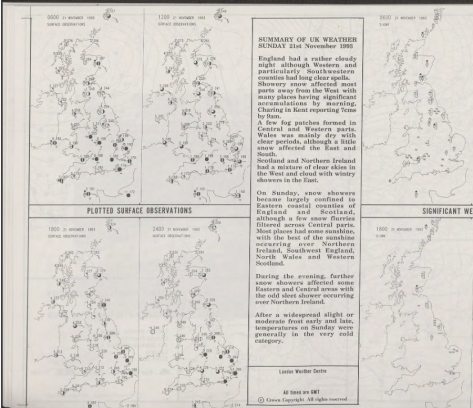
November has produced some potent snowfalls in Scotland and northern England over the past 150 years. These brief shots of cold air, often direct from the North Pole, however very rarely produce anything that can sustain long-lasting low-level snow in London and the Home Counties.
With the GFS weather model occasionally hinting at a blast of polar maritime air I decided to have a look back through the records to see how frequently the capital has turned white during the eleventh month.
Anyone who is familiar with the Objective Lamb Weather Type (LWT) data series will know that there may be an increased likelihood of things turning colder at some point this month. Last month was the joint 5th most anticyclonic October in the LWT series data series that runs from 1871; resulting stats closely resemble both October 1946 and 1962 as being very anticyclonic. Another similar year is 1972.
November 1972 was mild till mid month and then turned much colder with snow in places. November 1962 was cyclonic till the 24th, and then anticyclonic, with a cold northerly outbreak from the 18th for a few days with snow, before turning rather mild. November 1946 in complete contrast to both years, was a mild, dull and very wet month.
The most impressive November snowy spells seem to have occurred in the late 1800s. These two 500mb reanalysis charts show a cold feed from Scandinavia in both cases.
Snow and sleet falling in the London area is obviously much more common than snow lying. The snowiest Novembers were in 1919 and 1952 when snow or sleet fell for 10 days at Wallington and Hampstead respectively.
Kew saw snow or sleet on 8 days in 1919, while Heathrow and Northolt recorded snow or sleet on eight days in 1952.

The only decent snowfall that occured in London in my lifetime was November 1993 – and I was abroad for that. I remember my dad mentioning it in a letter written to me as I travelled round China. It arrived in the early hours of one Sunday morning and fell to a depth of five inches.
Given that was the last time London saw a decent fall I won’t be holding my breath that we’ll see any this month – though, if you live in Scotland, the odds are much narrower.
Before 1861 information on snowfalls becomes scarce – at least in terms of correct quantity. However, heavy snowfalls obviously did occur. On November 17, 1816, the Inverness Journal contained this report:
“The winter has commenced with a severity almost beyond example. Frost, rain and snow have been almost incessant during the last week and the greater proportion of corn still uncut or in stocks has suffered material injury.
“We regret to say that several lives have been lost. A postboy of Bennet’s coming from the south was obliged to leave his chaise on the road and would have been lost but for the lights shown from the windows of Moyhall which he reached nearly in a frozen state. The obvious advantage of keeping lights in stormy nights in the windows of houses in the country has thus been illustrated
“The winter it appears has set in with extreme severity in the interior of the continent. At Augsburg on the 19th of November the eclipse of the sun was entirely obscured by a fall of snow which commenced at 7 o’clock in the morning and lasted till noon. The ground was covered with snow a foot in depth. There was a great fall of snow at Frankfurt on the same day and Reaumur’s thermometer showed at from 9 to 10 degrees below the freezing point.”
Perhaps the most impressive, modern day snowfall in the south of the UK occurred around November 18th 1972 when observers recorded 60cm of snow on Dartmoor. Synoptic charts and other data are attached below.


- Inspiration for this piece came from Dr Richard Wild’s PhD study on snowfall which you can find here.







HI, I feel it is always good to listen, for now at least anyhow, to the BBC Weather longer-range forecasts of an evening (21:55) on BBC News Channel. I note on last night’s broadcast there was talk of a brief polar incursion and chance of snow on the highest peaks of Scotland for the end of this week. Time will tell.
Regards
Tony Powell and naturestimeline
LikeLike
Yes, quite possible. The chance of a decent fall of snow in Scotland is 30% in any given year. Down here it is only 3% – the last one was in 1993.
LikeLiked by 1 person
November 1807 – not well-known even to experts – must have been a horrible month for all except snow-lovers. Although only the third-coldest November by CET since 1659, it was so cold further north that Scotland likely had something close to a subzero mean. At Gordon Castle the mean was only 0.8˚C versus 3.3˚C in November 1915 and 1.9˚C in November 1782, whilst at Edinburgh the average was a remarkable 1.1˚C versus 2.0˚C in November 1782 and 3.0˚C in November 1915.
What’s interesting is that, despite being so cold in a month where the CET/EWP correlation is firmly negative (I did a blog post showing these relationships and outliers at ‘http://jpbenney.blogspot.com.au/2015/11/monthly-and-seasonal-ewp-versus-cet.html’ where I examine the similar cold and snowy – but abnormally sunny – November 1910) November 1807 was on the wet side at least in southern England. The average EWP of 115.5 millimetres is exceptional for so cold a month – apart from 1910 the coldest wetter November was 1878 with 3.5˚C and then 1861 with 4.2˚C in an era when highly continental Novembers were the rule rather than as today a curiosity.
LikeLike